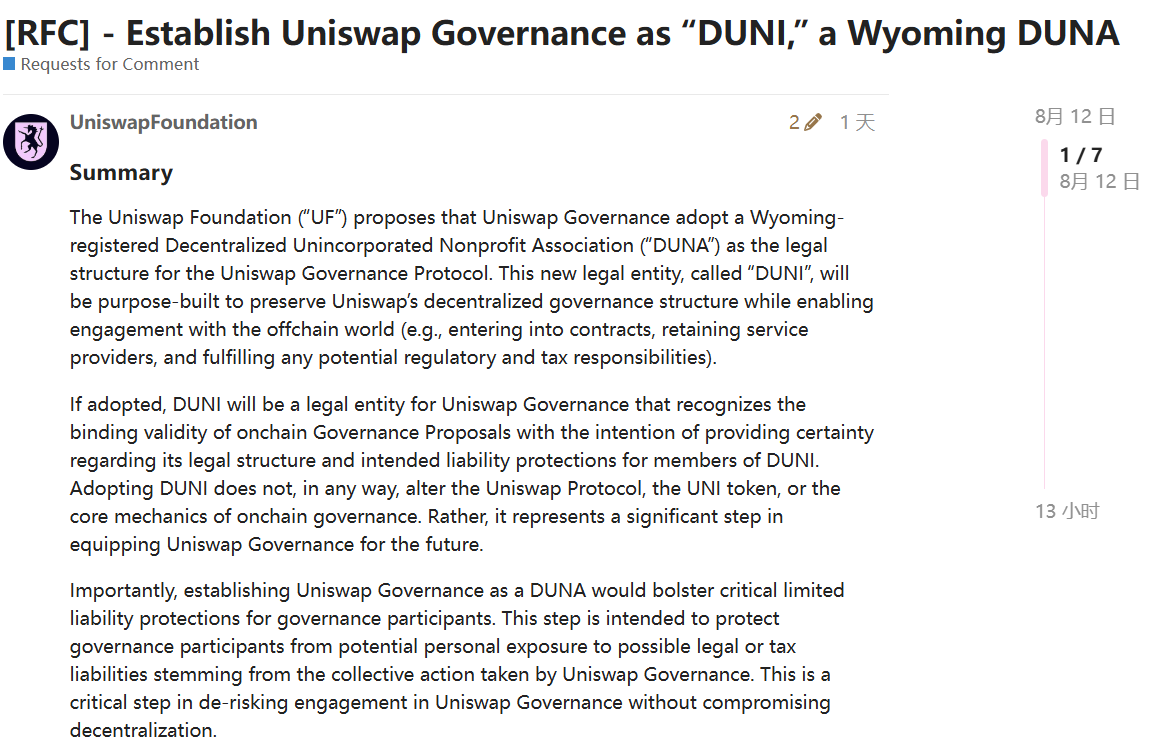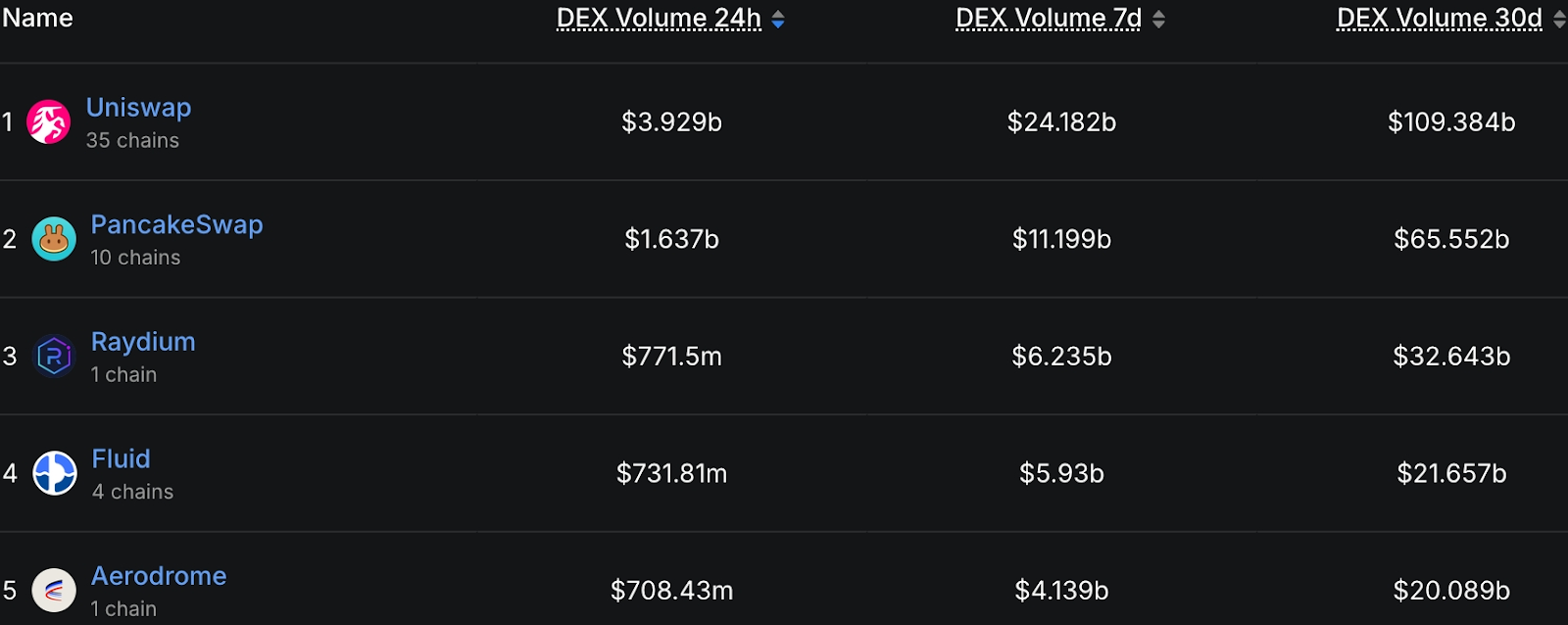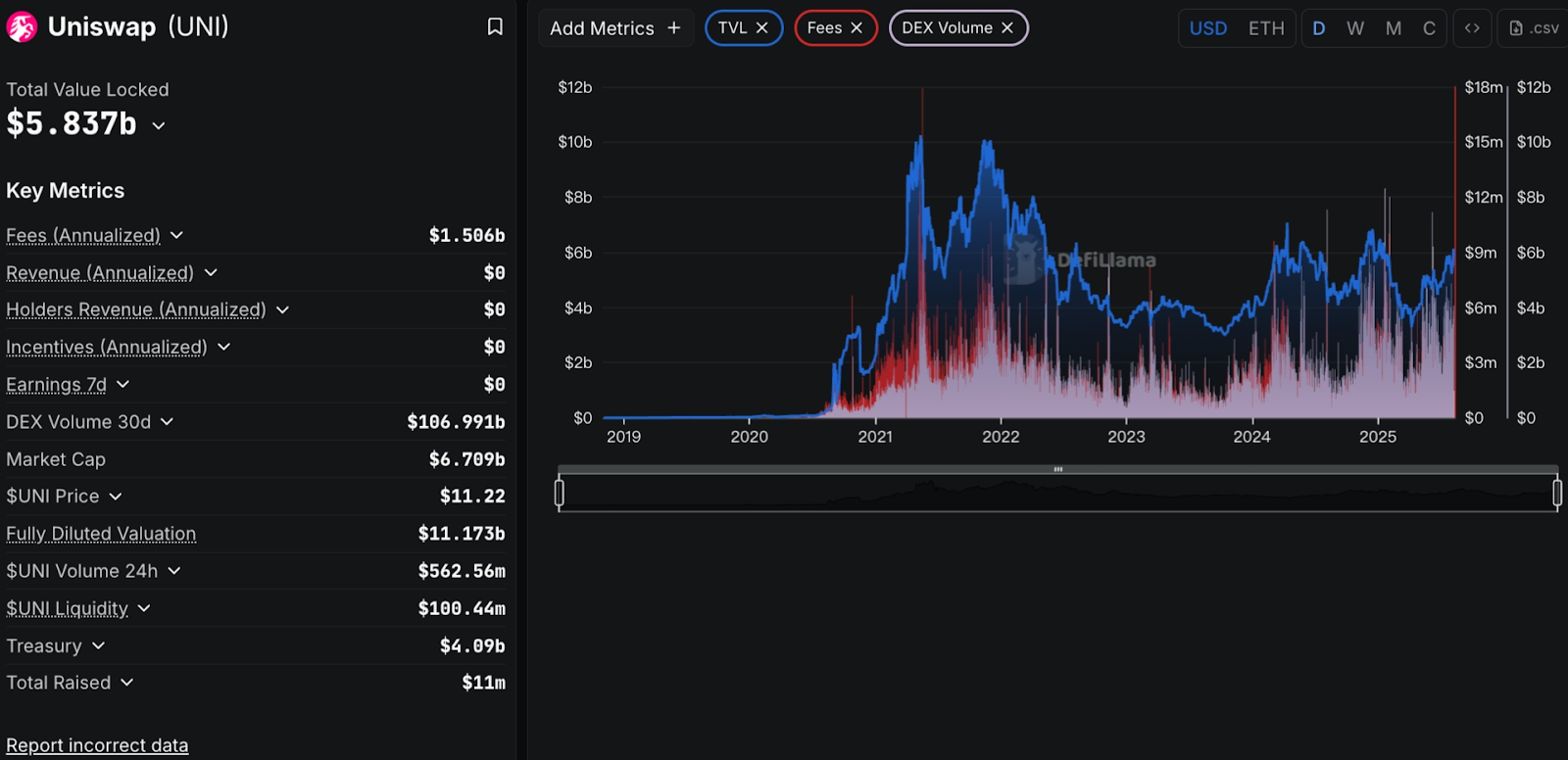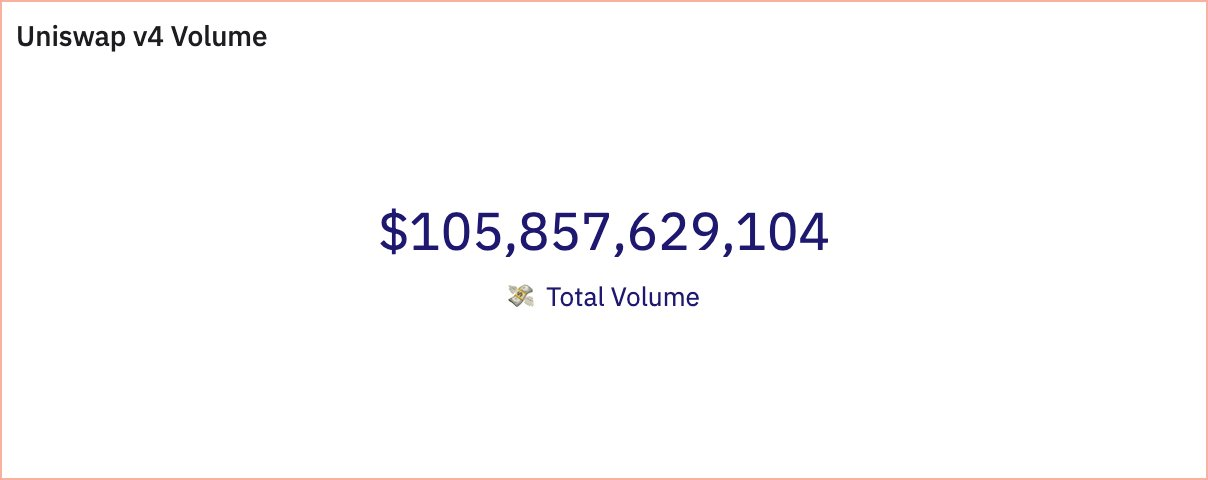Introduction
Over the past two years, Uniswap has been trapped in a valuation paradox: as the leading protocol in DeFi, it boasts the highest trading volume and transaction fees in the industry, yet it has failed to provide even a penny of return to token holders.
However, as we enter 2025, Uniswap's story seems to be entering the next phase. The protocol itself is changing, governance is evolving, and the only constant is that the market continues to price UNI using a "0% distribution" logic.
When we attempt to answer the valuation question regarding UNI:
Based on the current various "favorable conditions," what should its reasonable valuation be?
Thus, it is time to reassess Uniswap.
1. Current Status of the Protocol: From the Narrative of No Dividends to the Reality of Being Undervalued
In February 2025, Uniswap finally reached a narrative-changing milestone—the U.S. Securities and Exchange Commission (SEC) announced the formal conclusion of its investigation into Uniswap Labs and stated that it "will not take any enforcement action."
This not only cleared years of compliance shadows for Uniswap itself but also sent a clear signal to the entire DeFi market: open financial infrastructure at the protocol level still has room to survive and expand within regulatory frameworks.
Meanwhile, Uniswap's product iteration has quietly completed a generational upgrade. At the beginning of 2025, v4 officially launched and completed multi-chain deployment. With the flexibility brought by the Hooks architecture, Uniswap's liquidity aggregation efficiency has further improved. The launch of the Unichain mainnet provides a more unified foundation and execution environment for subsequent expansion. The actual performance quickly provided feedback: in May 2025 alone, Uniswap's monthly spot trading volume reached $8.88 billion, setting a new high for the year, with a total trading volume of $109 billion over the past 30 days.
In addition to the rebound in trading volume and the launch of v4, Uniswap has also welcomed a potential key change at the governance level. On August 12, the Uniswap Foundation (UF) proposed to register a decentralized non-profit association (DUNA) in Wyoming and establish "DUNI" as the legal entity for Uniswap governance.

This means that in the future, the Uniswap DAO will have a legal identity, enabling it to sign contracts off-chain, hire partners, fulfill tax compliance, and recognize the legal validity of on-chain governance. Most importantly, DUNI will provide limited liability protection for governance participants, significantly reducing personal legal or tax risks that may arise from protocol decisions. This structural improvement perfectly fills the last gap for the implementation of a dividend mechanism: the previously untouchable "legal gray area" is being filled by the system. Once DUNI is established, the protocol's income will truly enter the DAO or UNI holders' hands, no longer just a "vision," but a step with a practical execution basis.
However, compared to the expansion pace of the protocol itself, the valuation pace of UNI remains on the old track—its price hovers around $10, and DefiLlama shows that its holders' income is $0, while the annual fees generated at the protocol level amount to nearly several billion dollars, yet not a single penny has flowed into the hands of UNI holders.
There are certainly reasons behind this. From the beginning, Uniswap's governance set the protocol income to "0% distribution," transferring all transaction fees to LPs. But now, the story is changing.
The DAO has initiated discussions on a trial to uniformly charge a 0.05% protocol fee for all pools in v3, and the "staking + delegation → distribution" UniStaker module has long been technically deployed. The removal of regulatory risks has made this distribution logic more feasible.
The problem is: the structure of the protocol has changed, but the market's pricing logic has not.
Uniswap is evolving from a "non-dividend infrastructure" to a protocol "with potential cash flow distribution capabilities." However, the market's pricing for this evolutionary path still remains in the past valuation system of "only telling stories, not discussing returns."
And this is precisely why we believe—now is the starting point for Uniswap to be reassessed.
2. Valuation Approach: Viewing Future Valuation Through Dividend Expectations
In the existing pricing logic, UNI is more often seen as a mere cryptocurrency. Without dividends and fee returns, the market naturally will not price it according to the logic of "ability to generate cash flow."
Once the premise of protocol distribution is established, the valuation logic for UNI will no longer be "market sentiment × liquidity game," but rather "distributable protocol income × distribution ratio × PE multiple."
In this case, the most direct valuation method is:
Expected Valuation = Expected Dividends for the Year × PE Multiple
- Dividends: Calculated using annual protocol income × distribution ratio.
- PE Multiple: In most DeFi protocols, a range of 40–60 times is common, but Uniswap's scale and income structure are sufficient to support a higher premium.
First, let's look at the scale. According to DefiLlama data, Uniswap's trading volume over the past 30 days reached $109 billion, significantly leading PancakeSwap's $65.5 billion and far exceeding Raydium's $32.6 billion. In other words, its monthly trading volume is close to the total of the top five DEXs in the market.

Comparing other DEX-related data, it is clear that Uniswap, which has already validated its cross-cycle capability and occupies an absolute share of industry income, has formed a "discontinuous" leading pattern. This advantage is not only due to its large scale but also reflects the sustainability of its income and the breadth of its distribution—it covers multiple chains such as Ethereum, Polygon, Arbitrum, and Optimism, with strong stability in liquidity and user base. Therefore, it can be priced similarly to traditional financial markets for blue-chip cash flow assets. At this scale, UNI, as the leader, has sufficient competitive barriers and bargaining power to enjoy a higher premium than the typical 40-60 times PE of ordinary protocols.

Secondly, compared to the current P/Fees/TVL ranges of other DEXs, leading valuations generally exceed those of second- and third-tier projects by 30% to 100%. Against the backdrop of global compliance narratives, expectations for fee switch implementation, and institutions' preference for allocating to top protocols, a reasonable conservative expectation for UNI's PE is calculated as:
Using the industry’s relatively low average of 40 times PE as a base * (1+30%~100%) = UNI PE = 52 times - 80 times
⬇️
Taking the median PE value as 66 times
Finally, PE is not a fixed number; it will fluctuate with changes in market interest rates, industry prosperity, and the competitive landscape of protocols. If you want to compare the income and valuation of other protocols horizontally, you can directly check the data on DeFiLlama and see where UNI stands in similar rankings. You will have an intuitive answer as to whether 66 PE is overvalued.
4. Valuation Derivation: Why Uniswap Could Be Worth $26 in the Future
So, if we view Uniswap from a traditional financial perspective, the most direct valuation method is a simplified version of the discounted cash flow (DCF) method: using the distributable cash flow for the coming year as a baseline, multiplied by the potential price-to-earnings ratio (PE), to arrive at a reasonable market value range.
In the past 30 days, Uniswap's total trading volume was approximately $109 billion. Based on an average fee rate of 0.3%, the total fees generated by the protocol during this period were about $327 million. Since the fee switch has not yet been activated, this income currently all flows to LPs; however, once the dividend mechanism is implemented, the protocol can distribute a certain percentage (assumed to be 10% to 25%) to UNI holders.
Annualizing the 30-day trading data gives us the annual distributable cash flow range:
- Distribution Ratio 10%: $109 billion × 0.003 × 0.10 × 12 ≈ $392.4 million
- Distribution Ratio 25%: $109 billion × 0.003 × 0.25 × 12 ≈ $981 million
(According to the Gauntlet report, Uniswap v3's fee switch mechanism supports splitting LP income at multiple levels of 10%-25%. Currently, DAO governance has also initiated a trial to uniformly charge a 0.05% protocol fee, indicating that the protocol is attempting to activate the possibility of dividends without harming LPs.)

In the current market environment, the PE level we reasonably inferred in the previous section is about 66 times. Plugging this into the calculation formula:
- Low Distribution Scenario (10%): $392.4 million × 66 ≈ $25.9 billion
- High Distribution Scenario (25%): $981 million × 66 ≈ $64.8 billion
Considering that the current total market value of UNI is only $10.5 billion, with a coin price of about $10.6 (as of 10 PM on August 8, 2025), this means that under different dividend ratios, the revalued theoretical price range would be:
- Low Distribution Scenario: Approximately $26.2
- High Distribution Scenario: Approximately $65.4
From the valuation results, even with a conservative 10% distribution ratio, the corresponding reasonable price has more than 2.5 times the upside potential compared to the current level. Under more aggressive assumptions, the potential revaluation could exceed 5 times.
In other words, the market's pricing of UNI is currently stuck in an "undervalued" period before the fee switch is activated. Once dividends are implemented, the cash flow logic will replace the simple trading volume sentiment, becoming the core force driving the upward shift in valuation.
Of course, a project's reasonable valuation is also subject to comprehensive evaluation of multiple factors, so it is unlikely that UNI will suddenly hit a valuation ceiling, making a target of around $26 still worth looking forward to.
5. The Reality and Imagination of Dividends: Opportunities, Paths, and Risks
At this point, you might ask: the idea of protocol distribution sounds great, but can it really be realized?
In fact, this question has been an unresolved issue hanging over the heads of leading DeFi projects for the past few years. Currently, Uniswap, in addition to the regulatory, governance, and technical issues mentioned above being properly addressed, is not the first mover in the industry:
- SushiSwap has incentivized token holders with "transaction fees" since its inception;
- Protocols like GMX and dYdX have long established a market mindset of "staking = income rights";
- New generation trading protocols such as Ambient, Maverick, and Pancake v4 have all integrated "distribution logic" during their launch phases.

However, this does not mean that risks have disappeared.
The fee switch has not yet officially launched, and all valuation expectations are still based on "reasonable" assumptions;
- The 2% perpetual inflation mechanism was initiated this year, and before dividends are realized, each new UNI actually dilutes the value of existing holders;
- Furthermore, the activation of the fee switch does not mean that everyone can "sit back and enjoy the benefits"; there may be thresholds for dividends, and the actual proportion of those who can enjoy cash flow distribution remains unknown.
- The most critical risk lies in the fact that everything still depends on the DAO's resolutions.
But this time, at least we have seen Uniswap moving forward with ambition.
Conclusion: Betting on Direction Beyond Valuation
At this point, it can be confirmed that Uniswap's valuation logic has indeed reached a turning point.
The only lagging aspect is market sentiment and pricing models.
From the current data, Uniswap's trading volume has returned to high levels, the distribution mechanism is beginning to show potential for implementation, and the cash flow model is reshaping the market's understanding of UNI. Compared to the vague narratives of the bubble period, today's Uniswap has a stronger foundation for "value return."
Of course, valuation models can only tell us: "If everything goes smoothly, how much can UNI be worth?"
But ultimately, the value of UNI lies not just in whether it can distribute dividends, but in whether it can regain its voice at the moments when the DeFi narrative is least favored.
Because the market may not always price rationally, but it will always catch up eventually. And this time, perhaps it is time to go back to class.
免责声明:本文章仅代表作者个人观点,不代表本平台的立场和观点。本文章仅供信息分享,不构成对任何人的任何投资建议。用户与作者之间的任何争议,与本平台无关。如网页中刊载的文章或图片涉及侵权,请提供相关的权利证明和身份证明发送邮件到support@aicoin.com,本平台相关工作人员将会进行核查。



